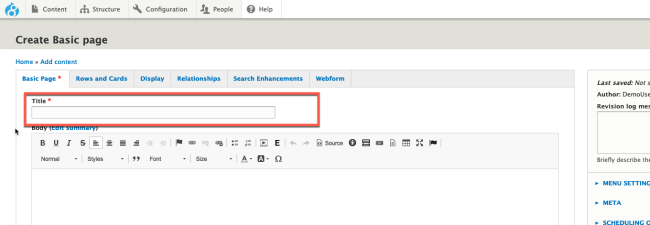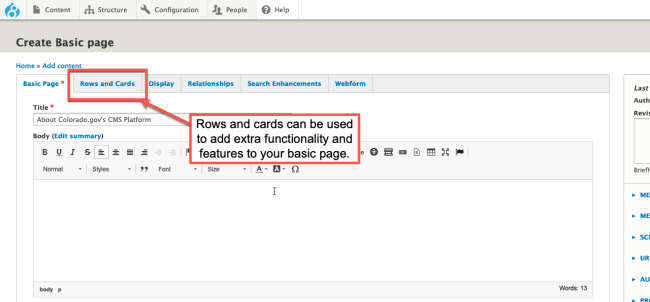This is the standard page type.The majority of the pages on your site will be comprised of basic pages. The tutorial down below will show you how to create a new basic page.
Step 1: Choose to Create a New Basic Page
Go to Content > Add Content > Basic Page.
Step 2: Add a Page Title
The page title should be intuitive and indicative of what is on your page. A good title will contribute to good Search Engine Optimization.
Step 3: Add the Page Content
Next, add the content to your page. Content can be added in one of two ways:
- The Body Field: If your page will mostly contain text and links, this is the best place to put it. The body field allows you to make page edits using the CMS WYSIWYG editor. For most pages, using the body field will likely be sufficient.
- Rows and Cards: This is a feature that allows you to customize the page layout and add lots of different kinds of functionality. This is a more advanced feature that we recommend users familiarize themselves with after learning the basics of the website platform. You can learn more about this in our Rows and Cards Tutorial.
Not done? No problem. Save the page and come back later to finish what you started.
Step 4: (Recommended) Add a Revision Log Message
While not necessary, it is generally recommended that you add a revision log message whenever making edits to a page, particularly large or important edits. This makes it easier to track changes made to a page in case you need to review the page's revision history, especially on pages that are updated regularly.
Step 5: (Optional) Set Additional Page Options
Basic Pages offer a lot of additional options that allow you to have more control over how your page is presented and functions. Depending on how your organization has set up their pages, many times, these settings can be skipped. In some cases, they may be necessary. A brief description of what can be done is listed below. Full tutorials on all these options can be found in dedicated training pages of this program.
- Display: Use these settings to..
- add a featured image
- add a left or right reference menu
- hide the main navigation bar (on only this page)
- hide the breadcrumbs (on only this page)
- Relationships: Use these settings to...
- Add tags to related pages to each other
- Add resource terms to add the page to faceted search
- Search Enhancements: Use these settings to....
- Manually modify your page's summary on your website's search results page.
- Archive the page to hide it from your website's search results page.
- Promote the page within your website's search results page to make it more visible.
- Webform:
- Display a webform you created with the CMS webform feature on the page. This is one of many ways to add a webform to a page.
Step 6: (Optional) Set Additional Page Settings
Additional settings can change other elements of your basic page. These are not necessary depending on how your organization has set up their pages. A brief description of these settings are listed below. Full tutorials of these settings can be found in dedicated training pages of this program.
- Menu Settings: Add the page to a menu (such as the main navigation).
- Meta: Configure meta page settings that provide extra page customization. This is an advanced feature.
- Scheduling Options: Set a date and time for when the page publishes or unpublishes.
- URL Alias: Manually customize the page's URL.
- Authoring Information: Access the page's original creator and authoring date info.
- Promotion Options: Create a private page.
Step 7: Save the Page
When finished, save your changes by clicking Save.
The page will automatically be saved as a Draft, but if you are ready for others to see the page, change the status of the page to Published. Learn more about publishing states in our Publish States tutorial.
Other Resources
Check out some of these other resources that may help.
Are you an EPM?
Entity Project Managers can open help tickets with our Service Desk.







